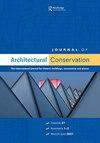Imitative material culture: towards a philosophy for the authentic conservation of historical artificial materials and imitative techniques
IF 0.5
3区 艺术学
0 ARCHITECTURE
引用次数: 1
Abstract
ABSTRACT This article extends the concept of the term ‘material culture’ and addresses the production and use of artificial materials and imitative techniques as a phenomenon, defined here as ‘Imitative Material Culture’. It includes consideration of social, economic, technological, historical, and artistic aspects of this culture. While extensive literature exists on specific imitative crafts, perceiving these crafts as a part of one’s culture has not been studied. Its rejection by William Morris, Augustus Pugin and John Ruskin, who promoted conservation in England, left a gap without a clear methodological and philosophical approach towards conservation of this cultural heritage. Its origins have been traced to the age of antiquity; however, imitative material culture reached its zenith between the seventeenth and the nineteenth centuries. The utilisation of marble imitations such as scagliola, marmorino and marezzo increased significantly during this period, most notably in Bavaria, and was later warmly embraced by the Georgians in the UK. Conservation of imitative material culture challenges our perceptions regarding authenticity, as there is an evident philosophical paradox between authentic imitations and authentic conservation within this heritage. Thus, the study provides a platform for choosing an appropriate conservation approach for historic artificial materials and imitative techniques.模仿物质文化:走向对历史人造材料和模仿技术进行真实保护的哲学
本文扩展了“物质文化”一词的概念,并将人工材料和模仿技术的生产和使用作为一种现象,在这里定义为“模仿物质文化”。它包括对这种文化的社会、经济、技术、历史和艺术方面的考虑。虽然存在大量关于特定模仿工艺的文献,但将这些工艺视为一个人文化的一部分尚未得到研究。威廉·莫里斯、奥古斯都·普金和约翰·拉斯金在英国倡导保护文化遗产,但他们的拒绝留下了一个空白,没有明确的方法和哲学方法来保护这种文化遗产。它的起源可以追溯到古代;然而,模仿物质文化在17世纪和19世纪之间达到了顶峰。在此期间,仿大理石如scagliola、marmorino和marezzo的使用显著增加,尤其是在巴伐利亚州,后来在英国受到格鲁吉亚人的热烈欢迎。模仿物质文化的保护挑战了我们对真实性的看法,因为在这种遗产中,真实的模仿和真实的保护之间存在着明显的哲学悖论。因此,该研究为历史人工材料和模仿技术选择合适的保护方法提供了一个平台。
本文章由计算机程序翻译,如有差异,请以英文原文为准。
求助全文
约1分钟内获得全文
求助全文

 求助内容:
求助内容: 应助结果提醒方式:
应助结果提醒方式:


